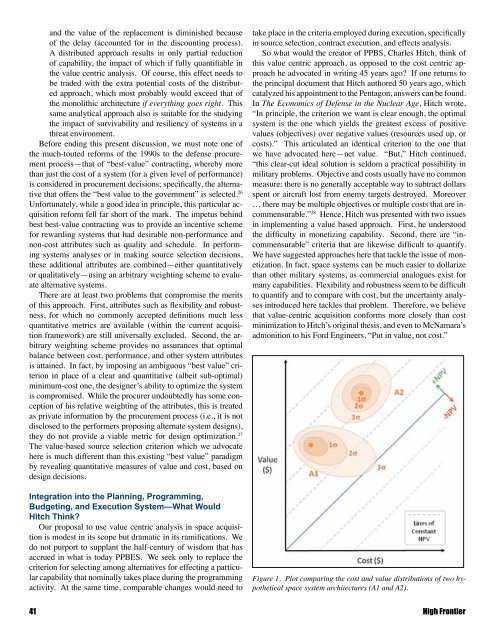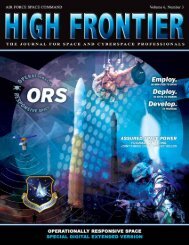Space Acquisition - Air Force Space Command
Space Acquisition - Air Force Space Command
Space Acquisition - Air Force Space Command
Create successful ePaper yourself
Turn your PDF publications into a flip-book with our unique Google optimized e-Paper software.
and the value of the replacement is diminished because<br />
of the delay (accounted for in the discounting process).<br />
A distributed approach results in only partial reduction<br />
of capability, the impact of which if fully quantifiable in<br />
the value centric analysis. Of course, this effect needs to<br />
be traded with the extra potential costs of the distributed<br />
approach, which most probably would exceed that of<br />
the monolithic architecture if everything goes right. This<br />
same analytical approach also is suitable for the studying<br />
the impact of survivability and resiliency of systems in a<br />
threat environment.<br />
Before ending this present discussion, we must note one of<br />
the much-touted reforms of the 1990s to the defense procurement<br />
process—that of “best-value” contracting, whereby more<br />
than just the cost of a system (for a given level of performance)<br />
is considered in procurement decisions; specifically, the alternative<br />
that offers the “best value to the government” is selected. 26<br />
Unfortunately, while a good idea in principle, this particular acquisition<br />
reform fell far short of the mark. The impetus behind<br />
best best-value contracting was to provide an incentive scheme<br />
for rewarding systems that had desirable non-performance and<br />
non-cost attributes such as quality and schedule. In performing<br />
systems analyses or in making source selection decisions,<br />
these additional attributes are combined—either quantitatively<br />
or qualitatively—using an arbitrary weighting scheme to evaluate<br />
alternative systems.<br />
There are at least two problems that compromise the merits<br />
of this approach. First, attributes such as flexibility and robustness,<br />
for which no commonly accepted definitions much less<br />
quantitative metrics are available (within the current acquisition<br />
framework) are still universally excluded. Second, the arbitrary<br />
weighting scheme provides no assurances that optimal<br />
balance between cost, performance, and other system attributes<br />
is attained. In fact, by imposing an ambiguous “best value” criterion<br />
in place of a clear and quantitative (albeit sub-optimal)<br />
minimum-cost one, the designer’s ability to optimize the system<br />
is compromised. While the procurer undoubtedly has some conception<br />
of his relative weighting of the attributes, this is treated<br />
as private information by the procurement process (i.e., it is not<br />
disclosed to the performers proposing alternate system designs),<br />
they do not provide a viable metric for design optimization. 27<br />
The value-based source selection criterion which we advocate<br />
here is much different than this existing “best value” paradigm<br />
by revealing quantitative measures of value and cost, based on<br />
design decisions.<br />
Integration into the Planning, Programming,<br />
Budgeting, and Execution System—What Would<br />
Hitch Think<br />
Our proposal to use value centric analysis in space acquisition<br />
is modest in its scope but dramatic in its ramifications. We<br />
do not purport to supplant the half-century of wisdom that has<br />
accrued in what is today PPBES. We seek only to replace the<br />
criterion for selecting among alternatives for effecting a particular<br />
capability that nominally takes place during the programming<br />
activity. At the same time, comparable changes would need to<br />
take place in the criteria employed during execution, specifically<br />
in source selection, contract execution, and effects analysis.<br />
So what would the creator of PPBS, Charles Hitch, think of<br />
this value centric approach, as opposed to the cost centric approach<br />
he advocated in writing 45 years ago If one returns to<br />
the principal document that Hitch authored 50 years ago, which<br />
catalyzed his appointment to the Pentagon, answers can be found.<br />
In The Economics of Defense in the Nuclear Age, Hitch wrote,<br />
“In principle, the criterion we want is clear enough, the optimal<br />
system is the one which yields the greatest excess of positive<br />
values (objectives) over negative values (resources used up, or<br />
costs).” This articulated an identical criterion to the one that<br />
we have advocated here—net value. “But,” Hitch continued,<br />
“this clear-cut ideal solution is seldom a practical possibility in<br />
military problems. Objective and costs usually have no common<br />
measure: there is no generally acceptable way to subtract dollars<br />
spent or aircraft lost from enemy targets destroyed. Moreover<br />
… there may be multiple objectives or multiple costs that are incommensurable.”<br />
28 Hence, Hitch was presented with two issues<br />
in implementing a value based approach. First, he understood<br />
the difficulty in monetizing capability. Second, there are “incommensurable”<br />
criteria that are likewise difficult to quantify.<br />
We have suggested approaches here that tackle the issue of monetization.<br />
In fact, space systems can be much easier to dollarize<br />
than other military systems, as commercial analogues exist for<br />
many capabilities. Flexibility and robustness seem to be difficult<br />
to quantify and to compare with cost, but the uncertainty analyses<br />
introduced here tackles that problem. Therefore, we believe<br />
that value-centric acquisition conforms more closely than cost<br />
minimization to Hitch’s original thesis, and even to McNamara’s<br />
admonition to his Ford Engineers, “Put in value, not cost.”<br />
Figure 1. Plot comparing the cost and value distributions of two hypothetical<br />
space system architectures (A1 and A2).<br />
41 High Frontier











